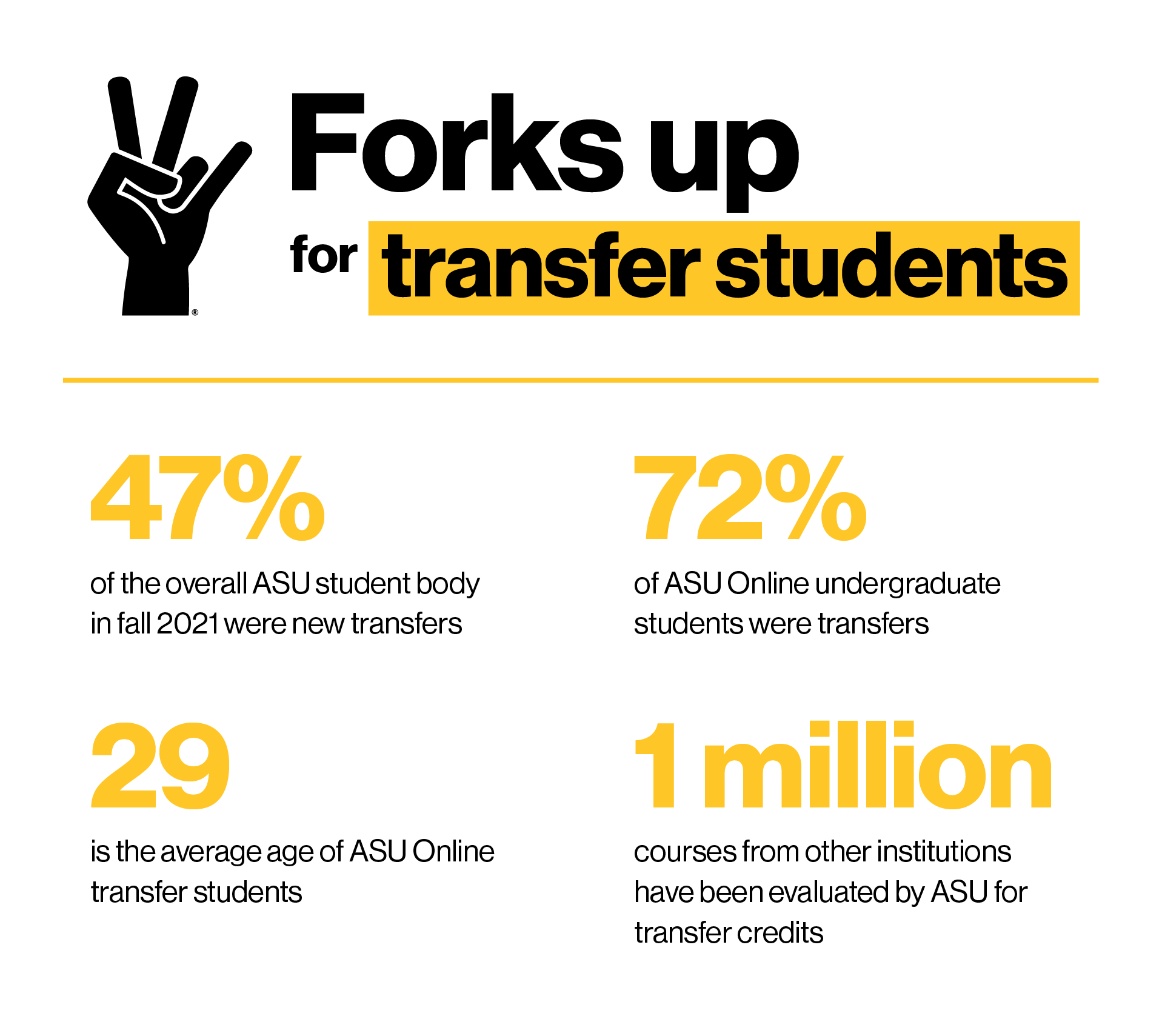Editor’s note: This story is featured in the 2022 year in review.
Most bachelor’s degree programs at Arizona State University require at least 120 credits.
Every one of those credits is hard won with serious work and sacrifice. So no student wants to see precious credits slip away when they transfer to ASU, with all those hours of coursework down the drain.
ASU works hard to make sure that transfer students can apply as much of their existing work as possible toward their degree.
One team of staffers at ASU recently hit a remarkable milestone – 1 million course equivalencies evaluated over the last 10 years.
“That means we have 1 million transfer courses from other institutions, domestic and international, that have been evaluated as receiving equivalency at ASU,” said Tanaya Dempsey, director of the Academic Transfer Credit Solutions unit, which is in the provost’s office at ASU.
That’s a big deal because of the number of students who come to ASU after starting their higher education somewhere else: In fall 2021, 42% of all undergraduates at ASU, both on campus and online, entered the university as transfer students. At ASU Online, 72% of undergraduates have transfer credits.
The growth of ASU Online’s enrollment has driven the surge in transfer credits, Dempsey said. Transfer students to ASU Online increased 70% from fall 2016 to fall 2021, including students in the Starbucks College Achievement Plan.
Smoothing the transfer process is critical for degree completion, so students don’t have to spend time and money on coursework they’ve already completed elsewhere.
The 1 million courses milestone is an example of the enormous amount of work that goes on behind the scenes to get students from admission to graduation at ASU.
“Our team prides itself on saying, ‘If a student doesn’t know we exist, we’re doing our job,’” Dempsey said.
Capturing credits
In an alarming statistic, only about 14% of community college transfer students actually earn a bachelor’s degree within six years, according to the Community College Research Center at Columbia University.
The reasons are complicated, with lack of money often hindering housing and transportation. But difficulty in transferring credits is one major barrier. A report from the U.S. Government Accountability Office found that nationwide, community college students who transferred from 2004 to 2009 lost, on average, about 43% of their credits.
One way for universities to remove barriers to access is to capture as many community college credits as possible.
At ASU, the Academic Transfer Credit Solutions team consists of 13 evaluators who work on 3,000 to 3,500 courses a week. When they approve a course for transfer credit to ASU, it becomes part of the Course Equivalency Search database in the ASU Transfer Guide, a standardized resource for students. That database now includes 1 million course equivalencies from regionally accredited domestic and international institutions, plus educational experiences completed during military service.
One of the ways ASU is working to leverage this 10-year accomplishment is through the work of the Academic Alliances team who seeks to partner with all domestic community colleges to promote these robust transfer pathways.
When students transfer from one of the nearly 80 two-year institutions that ASU has a partnership with, the process is typically seamless. Students now enrolled in a two-year college can ensure a smooth transition by signing up for MyPath2ASU, a personalized course-by-course transfer map that minimizes the loss of credit by helping students select the right courses for their intended major at ASU.
“MyPath2ASU debuted two years ago as a way to consolidate and offer access to several tools, bridging the Transfer Guide and the major maps,” Dempsey said.
Her team works with faculty to decide whether coursework from another institution meets the ASU’s standards to be applied toward a degree and not just accepted as elective credit.
The team researches the content of the course at the previous institution and asks for a full syllabus for ASU faculty to review.
International transfers can be especially complicated, Dempsey said.
“We have to see if their institution is recognized by the ministry of education in their country,” she said.
“And most institutions abroad don’t necessarily count credits the same way we do, 120 for a bachelor’s. Some have more and some have less.
“Students in the U.K. go for three years, and China doesn’t translate credits one for one.”
Access to international course content can be difficult.
“Bigger institutions in China or India will have translated catalogs, but small institutions don’t, and sometimes they don’t even have a website,” she said.
Also, faculty members in some other countries own their syllabi and don’t have to share them.
“It might be five credit hours there and half of that here,” she said. “It’s a lot harder for international students, so we try to make it easier for them to know.”
Overcoming glitches
Nguyen Khoi “Korey” Phung transferred last year from Arizona Western College and is now majoring in psychology on the Tempe campus.
“Since I transferred from an in-state community college, everything was smooth,” he said.
“But since I went to high school abroad, I didn’t have my high school records and I had trouble with that,” said Phung, who is from Vietnam.
“I had to fax my high school records and I didn’t even know what a fax machine was.
“I had to go through many steps before I was finally admitted to ASU.”
Now Phung works as a Transfer Student Ambassador, helping other students like him.
“I feel like I can use my voice to help incoming transfer students who maybe have the same issues I did,” he said.
“I always want to help people. I’m a psychology major and want to be a therapist.”
Brenda Melchor graduated from Cochise College in Sierra Vista, Arizona, in 2018 and is working toward a degree in criminology and criminal justice through ASU Online. She had originally transferred to another university but found the experience difficult.
“It was liking fighting tooth and nail to get any information or assistance,” she said. “I was having to dig and find out answers for myself.”
In fall 2020, she started at ASU Online in the 4+1 program, in which she’ll earn an undergraduate and a master’s degree.
“It was a complete difference. People were willing to explain things and then if I had any follow-up questions, they were available.”
Melchor paused her education while she worked as a long-haul trucker, and then resumed.
“They were like, ‘Oh yes, we have everything ready for you,’ “ she said.
Still, Melchor faced a hiccup in trying to transfer her Arizona General Education Curriculum – a set of community college general education courses that is wholly transferrable to all three of Arizona’s public universities.
“My advisor had to look that one up, but once we got that, it’s been smooth sailing ever since,” she said.
Melchor said that students should stay involved in the transfer process.
“There are some things that people need to watch out for, like credits from a certain number of years ago that don’t always apply,” she said.
“People need to make sure they’re maintaining contact with advisors.”
What’s ahead
ASU’s academic advisors are the Academic Transfer Credit Solutions unit’s biggest “clients,” and the team has been tweaking the process to help them.
“They’re the voice for the student and they know the ins and outs of the majors,” Dempsey said.
And the Transfer Guide is being fine tuned to be even more helpful.
“While it helps all transfer students, if you haven’t been in school for 10 years, you may not feel comfortable with what you’re seeing in the Transfer Guide,” Dempsey said.
“We’re getting feedback from those students to see how we can make it better and they can see themselves in this tool.”
ASU has partnered with every two-year institution, including tribal colleges, in Arizona, as well as many in California. One of those is Santa Monica College.
“Congratulations to Arizona State University on achieving this milestone — something we at Santa Monica College applaud because enhancing the streamlined pathway to a renowned public university like ASU is of crucial importance for community college students, who come from diverse backgrounds and often persist despite great socioeconomic obstacles,” said Kathryn E. Jeffery, superintendent and president of Santa Monica College.
“We are so pleased to have had the opportunity to offer our students a seamless transfer experience through the MyPath2ASU program, and look forward to how this new achievement will help accelerate SMC students’ career and transfer goals,” she said.
One of the ways ASU is working to leverage the 10-year accomplishment is through the work of the Academic Alliances team, which is seeking to partner with all domestic community colleges to promote transfer pathways.
Those agreements do more than just simplify credit transfer, Dempsey said.
“For students, it’s ‘I’ll takes these courses my first two years and I’ll know how they transfer.’ But then that info gets sent to our admission office, so when they’re getting close to transfer, they get information on how to register, plus personalized emails from their college, and they’re invited to online or in-person events,” she said.
“It’s ‘Here’s how we can help you,’ and we offer that to two-year institutions at no cost.”
Top image courtesy Pixabay
More University news

‘The time to change the future is now’
More than two decades ago, Arizona State University reimagined higher education by evolving into a university focused on inclusion rather than exclusivity and combining broad access and excellence…

3 ASU students earn Goldwater Scholarships for STEM research excellence
Three Arizona State University students have been named Goldwater Scholars for 2025, placing them among the nation’s most promising undergraduates pursuing research careers in science, engineering…

Provost Teaching Awardees, Charter Professors empower local communities, students
The ASU Charter embodies the university’s commitment to student success and research of public value and responsibility to the community. In recognition of its importance, each year, Executive…



